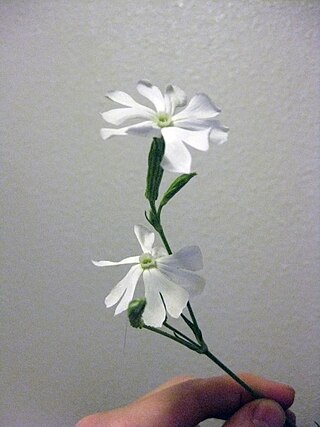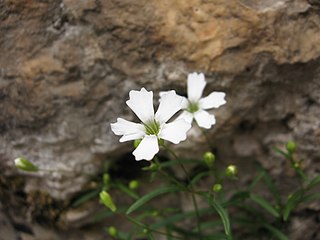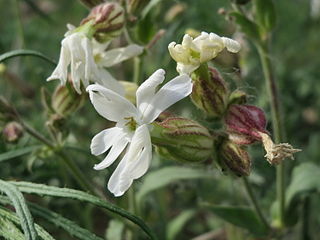
Silene is a genus of flowering plants in the family Caryophyllaceae. Containing nearly 900 species, it is the largest genus in the family. Common names include campion and catchfly. Many Silene species are widely distributed, particularly in the northern hemisphere.

Silene virginica, the fire pink, is a wildflower in the pink family, Caryophyllaceae. It is known for its distinct brilliant red flowers. Fire pink begins blooming in late spring and continuing throughout the summer. It is sometimes grown in wildflower, shade, and rock gardens.

Silene acaulis, known as moss campion or cushion pink, is a small wildflower that is common all over the high arctic and tundra and in high mountains of Eurasia and North America. It is an evergreen perennial flowering plant in the carnation family Caryophyllaceae.

Silene latifolia, commonly known as white campion, is a dioecious flowering plant in the family Caryophyllaceae, native to most of Europe, Western Asia and northern Africa. It is a herbaceous annual, occasionally biennial or a short-lived perennial plant, growing to between 40–80 centimetres tall. It is also known in the US as bladder campion but should not be confused with Silene vulgaris, which is more generally called bladder campion.

Silene dioica, known as red campion and red catchfly, is a herbaceous flowering plant in the family Caryophyllaceae, native to Europe and introduced to the Americas.

Lydia Ernestine Becker was a leader in the early British suffrage movement, as well as an amateur scientist with interests in biology and astronomy. She established Manchester as a centre for the suffrage movement and with Richard Pankhurst she arranged for the first woman to vote in a British election and a court case was unsuccessfully brought to exploit the precedent. Becker is also remembered for founding and publishing the Women's Suffrage Journal between 1870 and 1890.

Silene nutans is a flowering plant in the genus Silene, most commonly known as Nottingham catchfly.

Silene vulgaris, the bladder campion or maidenstears, is a plant species of the genus Silene within the family Caryophyllaceae. Native to the Old World, the plant has been naturalized elsewhere, including North America. The young shoots and leaves are edible.

Silene undulata is a plant native to the Eastern Cape of South Africa.

Microbotryum violaceum, also known as the anther smut fungus, was formerly known as Ustilago violacea. It is a basidiomycete obligate parasite of many Caryophyllaceae. But it has now separated into many species due to its host specificity.

Succisa pratensis, also known as devil's-bit or devil's-bit scabious, is a flowering plant in the honeysuckle family Caprifoliaceae. It differs from other similar species in that it has four-lobed flowers, whereas Scabiosa columbaria and Knautia arvensis have five lobes and hence it has been placed in a separate genus in the same family. It also grows on damper ground.

Hadena silenes is a species of moth of the family Noctuidae. It is found in Europe, Turkey, Israel, Iran and Turkmenistan.

Silene noctiflora is a species of flowering plant in the family Caryophyllaceae known by the common names night-flowering catchfly, nightflowering silene and clammy cockle. It is native to Eurasia, but it is known on other continents as an introduced species and sometimes a weed. In North America, it is a common weed of grain crops in the Canadian prairie provinces and in much of the United States. It grows in fields and in other disturbed habitat.

Heliosperma is a genus of flowering plants in the family Caryophyllaceae. As such, it is closely related to the large genus Silene, but its members can be told apart from Silene by the crest of long papillae on the seeds. The majority of the species are narrow endemics from the Balkan Peninsula, but H. alpestre is endemic to the Eastern Alps, and H. pusillum is found from the Cordillera Cantábrica in northern Spain to the Carpathians. Like members of the genus Silene and other related genera, Heliosperma is attacked by species of the anther smut fungus Microbotryum. Cases of parallel divergence events between alpine and mountain populations have been reported in this genus.

Silene uniflora is a species of flowering plant in the family Caryophyllaceae known by the common name sea campion.
Microbotryum silenes-dioicae is a species of fungus first isolated from Brittany, France. Its name refers to its host species, Silene dioica. The fungus is the cause of anther-smut disease, which results in fungal spores replacing the pollen in the anthers. The species that most resembles ‘’M. silenes-dioicae’’ morphologically is M. lychnidis-dioicae.

Microbotryum violaceum is a host-specific anther smut (fungus) disease that infects Silene latifolia and sterilizes the host plant. When infected with this disease, the flowers generate pathogenic spores, which can then be transferred to other plants by pollinating insects. Therefore, this disease is sometimes classified as a sexually transmitted infection.

Silene nivalis is a flowering plant in the pink family (Caryophyllaceae) native to Romania. A smut fungus, Microbotryum violaceum affects the anthers.

















